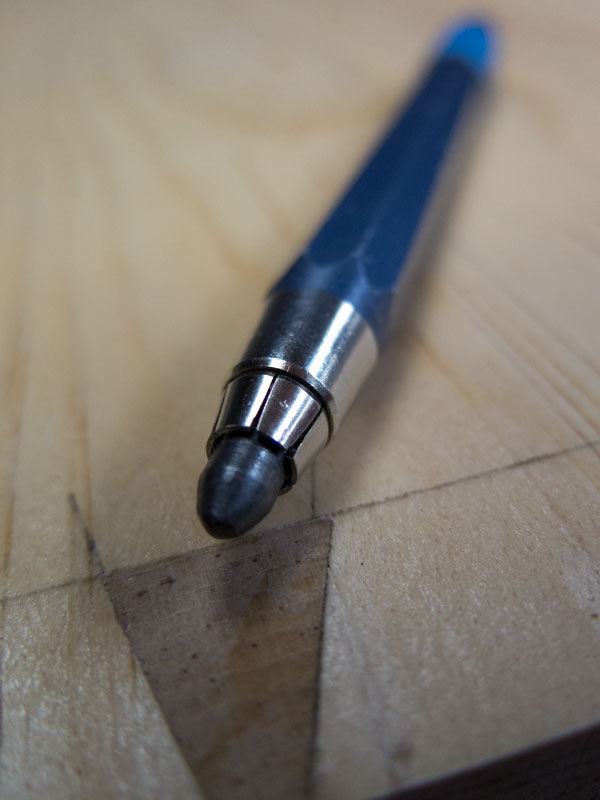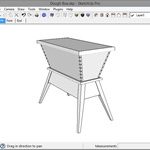We may receive a commission when you use our affiliate links. However, this does not impact our recommendations.
Full disclosure: The following gift ideas are 100-percent unsponsored. I bought all these tools myself and would buy them all again – that’s why they are on this list.
First on my list for 2014 is a tool you don’t see much in woodshops, but you should. It’s called a “lead holder” by artists and architects and it basically what a normal mechanical pencil would look like if you were hit by a shrink ray.
A lead holder grasps a long stick of lead that you can sharpen or carve to any shape. The lead is robust and difficult to break. And it leaves a bold mark even if you use little downward pressure.
A student in Germany turned me on to these marking devices about four years ago and I use them constantly to mark lumber throughout all phases of a project – from crosscutting rough stock to circling areas of tear-out that need to be removed before finishing.
Unlike a carpenter’s pencil, this thing is almost unbreakable and never needs to be carved back. And it’s easier to use than a lumber crayon.
After burning through a few different kinds I did a lot of research and bought this one from Art Alternatives. It is shockingly well made for an $8 item. Mine has been all over the world, dropped, kicked and accidentally thrown across the floor. And it still works.
The lead holder comes with extra lead and a metal case (which I now use to store coping saw blades).
Highly recommended.
— Christopher Schwarz
Here are some supplies and tools we find essential in our everyday work around the shop. We may receive a commission from sales referred by our links; however, we have carefully selected these products for their usefulness and quality.











Couldn’t agree more, Chris. These were part of the required kit when I went to art school and I immediately bought one just for my toolbox. I use the Koh-i-nor brand as well. I recommend if you want one that you buy a lead pointer as well, though you can get a decent chisel-tip with fine sandpaper, the pointer is my preference because it’s quick and uses up less sandpaper. They’re available from DickBlick: http://www.dickblick.com/products/alvin-rotary-lead-pointer/?clickTracking=true&wmcp=pla&wmcid=items&wmckw=21411-1025&gclid=CNKw7dbryMICFQiVfgodAkUAAw
When I took my mechanical drawing class in 1957, I bought a couple of lead holders to use, along with a paddle that had stacked sheets of sandpaper on it for sharpening. In those days, we ground the lead to a “chisel point” (i.e., flat on two sides) so that our lines would have a constant width. We used art gum erasers and “scum bags” to dust rubber shavings onto our drawings so our tools would move easily on the paper without leaving marks.
I’ve had a couple Staedler 2 mm lead holders in the shop for about 18 mo. The first has 2B lead for marking most woods. The second has a white lead for marking Walnut. Then I got a 3rd with HB lead for using on paper. The HB and 2B used together are good for doing furniture sketches. Love those things.
Like “duckfarmer” I also learned the value of a mechanical pencil in drafting class. you need one of the small lead sharpeners and you might try using “HB “lead works, well and you don’t have to press as hard, less indention to sand off.
Any idea if the Art Alternative is the same product as in the Czech Republic (for your EU readers)?
I spent the summer of 2013 at the Center for Furniture Craftsmanship in Rockport, Maine. Of all the tools required for the course, this is the one most used – then and today.
I have to laugh Chris. Guys my age (over 65) who took mechanical drawing in high school, worked as a draftsman or engineer remember those all too well. Still use at my drawing table in the shop all the time but have never happened to use at the bench on wood – have several, non probably newer than the 70s. Might have to try the ‘dual use’.
Just goes to show how you can use something for 50 years and still find a new use.
Dale
Brilliant!
Ordered.
Thanks Chris
I use the same thing – I have several – I also have one from Rockler that is LARGE but works just fine as it is easy to grasp and doesn’t roll. It (and the others) sharpens in my rotary desk sharpener.
I can put a blunt point or needle point or anything in between on it.